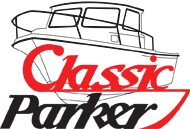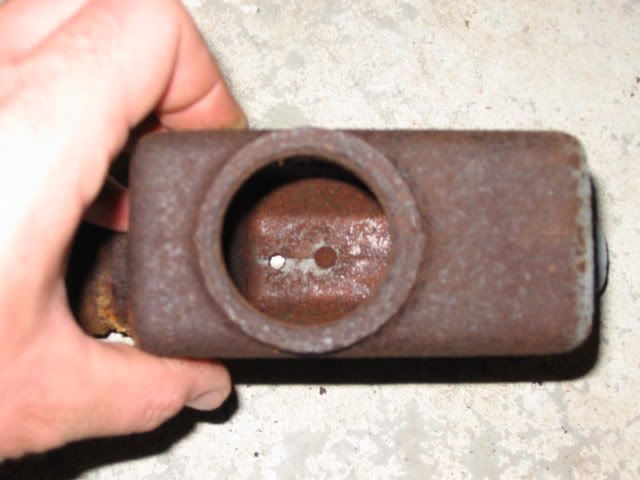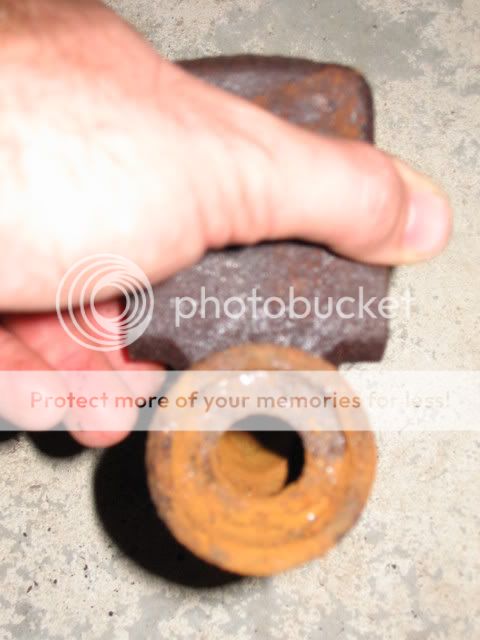Ok...I was in a hurry to finish the task so I could support Wish-A-Fish on Saturday, 26 Aug. So, I took the shortcut and pierced the checkvalve rather than disassembling the actuator and master cylinder.
Took the brake line off the rear of the actuator unit. Removed the tubing adaptor (part #23 in the Titan/Dico 10 actuator diagram), and tried to pierce with a long sharpened nail. No go...the checkvalve kept moving away from me riding in the bore of the master cylinder under spring pressure. So...I chucked a 1/16" drill bit in my handy-dandy DeWalt battery operated drill and drilled it out. Very soft metal, and went very fast. I flushed the master cylinder body with fresh brake fluid (pumping the break-away lever) to ensure no drillings were in the body, that might gum up the works. Reassembled, and bleed the brakes.
This particular actuator gets bleed by pulling back on the break-away lever (directions are in the Titan/Dico 10 pdf you can download from their site).
It was getting dark, and I didn't get pictures of either operation.



First test ride was from home to Sandy Point State Park near Annapolis, MD. Took about 35 minutes to get there at 55-60 mph. Tested the brakes several times (come up to speed, apply the brakes to replicate a quick stop), and they were obviously working...I didn't get that "pushy feeling" I had with the inop drum brakes. When I got to SPSP, I checked the temp of the hubs. They were much hotter than the idler hubs on the other axle, but not too hot to put my hand on and hold there. Since I had done my high speed stops on the side road approaching the park, I figured the heat was from the braking.
Went fishing and supported WAF.
On the way back home, I was careful to not apply the brakes to the trailer (did my best to coast to a slow roll through lights and intersections). Checked the hub temp about 1/3 of the way home on a wide siding on the Interstate. Hubs were still hotter than the idlers, but as before I was able to keep my hand on them. Figured that maybe the bearings were too tight. I've done wheel bearings a thousand times, and figured I didn't screw this up.
When I got home, I backed the trailer into my drive (up hill). Durn brakes caused my testosterone loaded Power Stroke to die...twice. The more coal I poured to that diesel the more those brakes worked against me...so obviouly those disks are working. Never had that with the drums. Even new, the drums couldn't match my PSD in reverse at idle. Not those Kodiak disks. So...one of the mods I'm going to have to add is a reverse lock-out solenoid.
Finally got her in place, but not after attracking the attention of the neighbors. Good friend wandered over and claimed it sounded like a tractor pulling contest over here. :shock: :shock: :shock:
Next day, I cleaned up the boat, and then turned my attention to the new hubs. Pulled a wheel to expose the hub and disk rotor/caliper assy. There was a slight dragging of pads on the disk rotor. Was able to push the pad on the wheel cylinder side back away from the rotor...so there was no residual pressure in the lines (piercing the checkvave worked). Wiggled the hub/rotor assy, and could feel a slight movement, which meant the bearings were not too tight (e.g., not preloaded).
So...it looks like I'll have to disassemble and clean/grease the actuator. It doesn't move to the rear and back to the relaxed position easy...sometimes I have to pop the clutch on the truck a bit to get it to pull out to the relaxed position. That is not the correct operation...it should slide forward simply by pulling the trailer forward with the truck. The actuator is not easily moving to the relaxed position, and therefore is probably giving me some residual pressure in the brake lines while in normal tow. The manual says they should give 5 years of service with "proper maintenance." Well...I haven't done squat to this actuator in the 4 years I've had it.
Will keep you posted on my actuator disassembly, cleaning, greasing, and reassembly (with pics of course). The disassembly will give me another chance to capture pics of bleeding the brake lines. I'll re-stage the pics of piercing the checkvalve while I'm at it. Since I'll be disassembling the acutator, I'll disassemble the master cylinder and remove the checkvalve (which is the manufacturer's recommendation anyway). So maybe I can attone for my my sin of not getting the pics last Friday.



 Drum-2-Disk 022 (Small).jpg55.8 KB · Views: 9,501
Drum-2-Disk 022 (Small).jpg55.8 KB · Views: 9,501 Drum-2-Disk 023 (Small).jpg52.1 KB · Views: 9,501
Drum-2-Disk 023 (Small).jpg52.1 KB · Views: 9,501 Drum-2-Disk 024 (Small).jpg52.8 KB · Views: 9,501
Drum-2-Disk 024 (Small).jpg52.8 KB · Views: 9,501 Drum-2-Disk 025 (Small).jpg48 KB · Views: 9,501
Drum-2-Disk 025 (Small).jpg48 KB · Views: 9,501 Drum-2-Disk 030 (Small).jpg51.8 KB · Views: 9,501
Drum-2-Disk 030 (Small).jpg51.8 KB · Views: 9,501 Drum-2-Disk 033 (Small).jpg21.9 KB · Views: 9,501
Drum-2-Disk 033 (Small).jpg21.9 KB · Views: 9,501

















